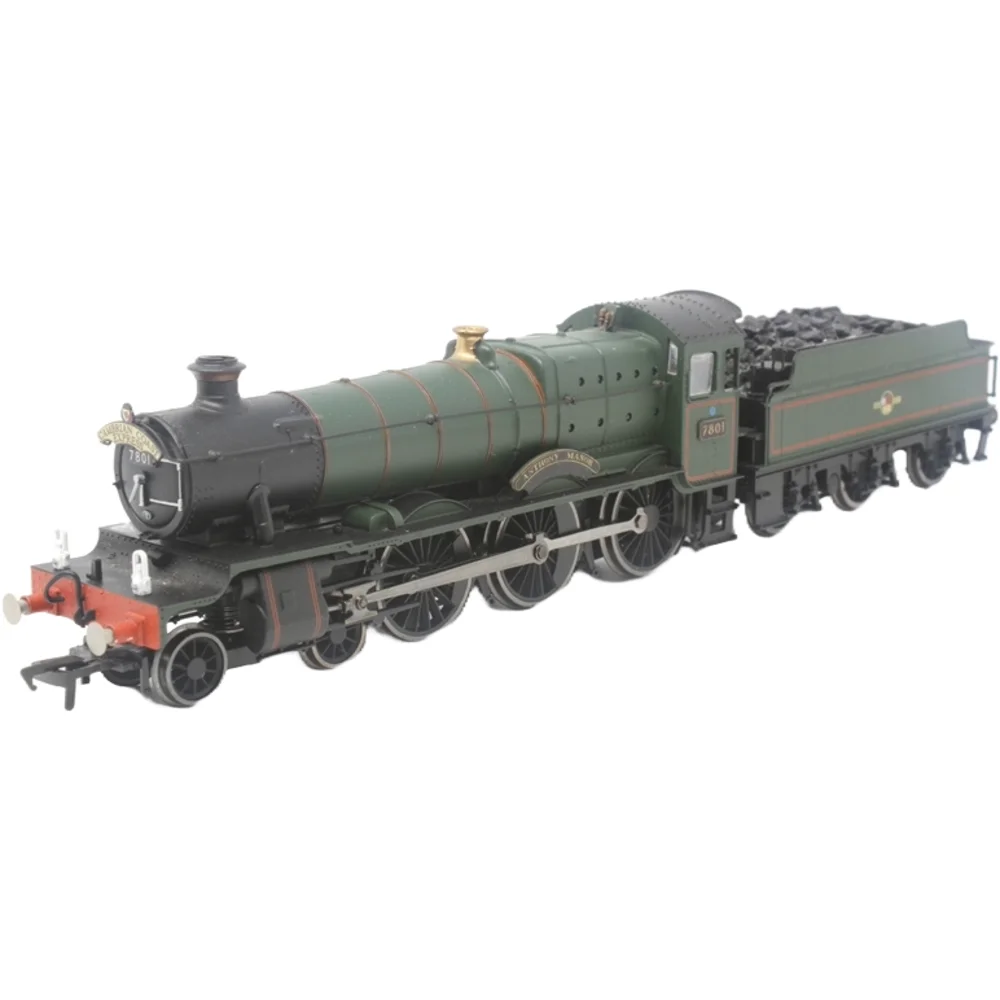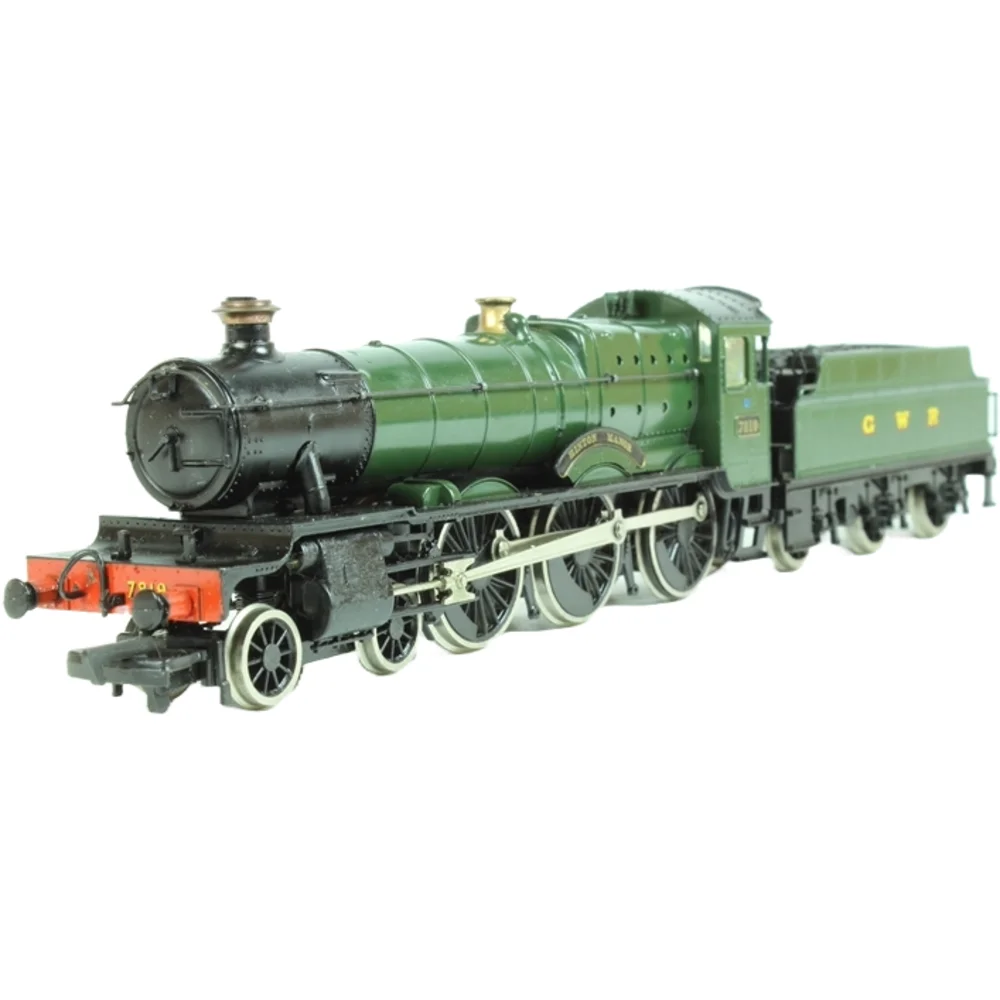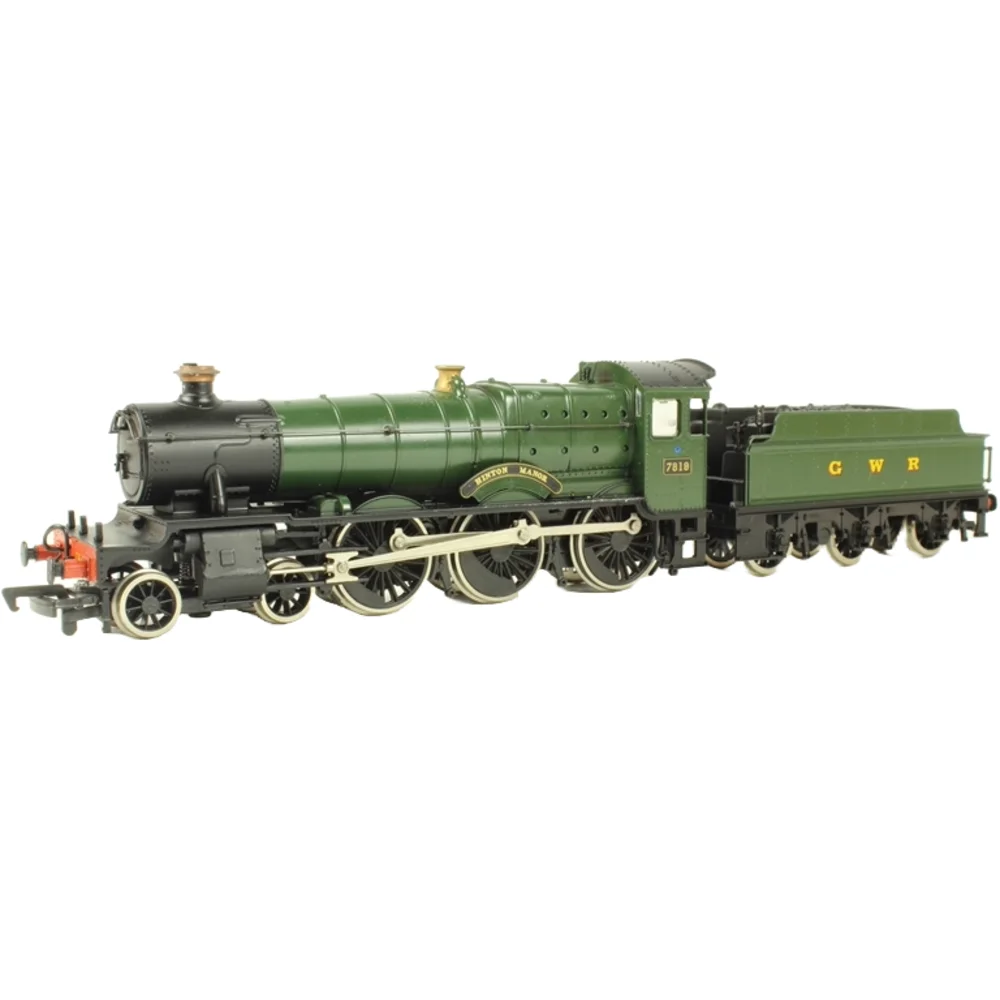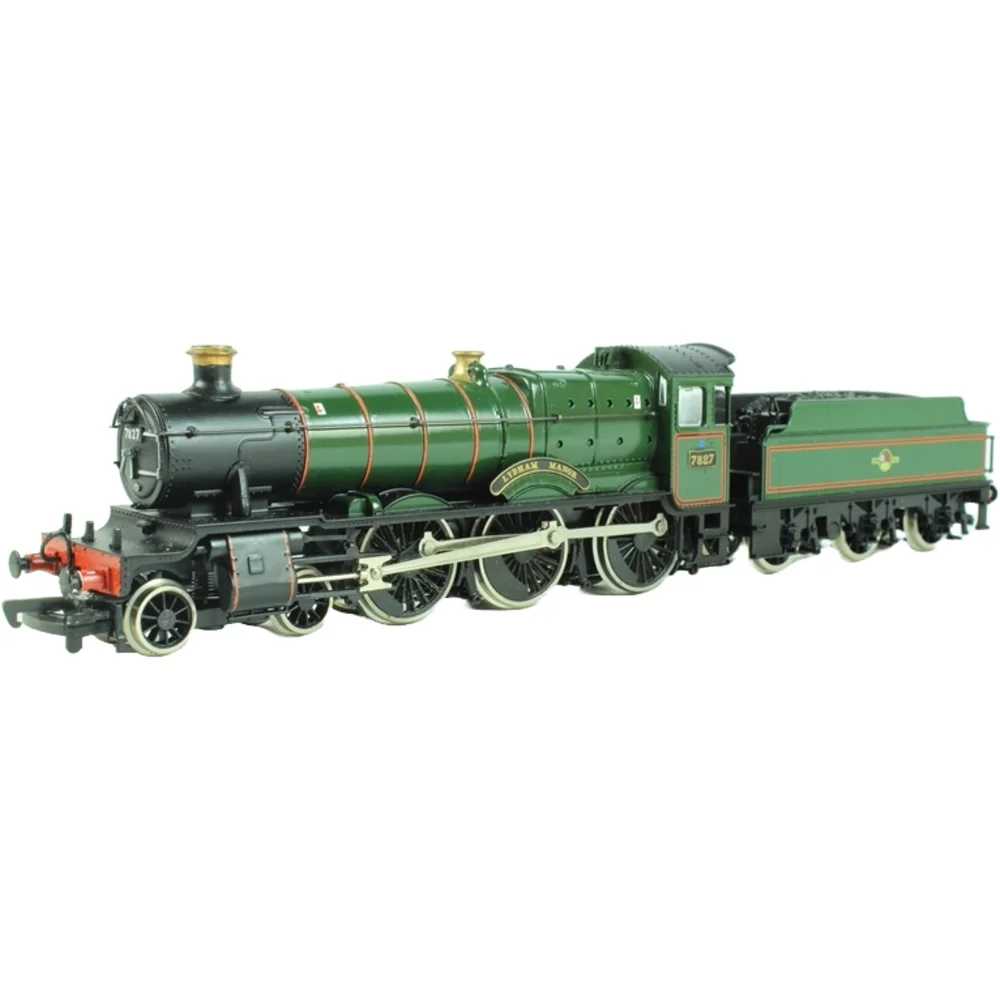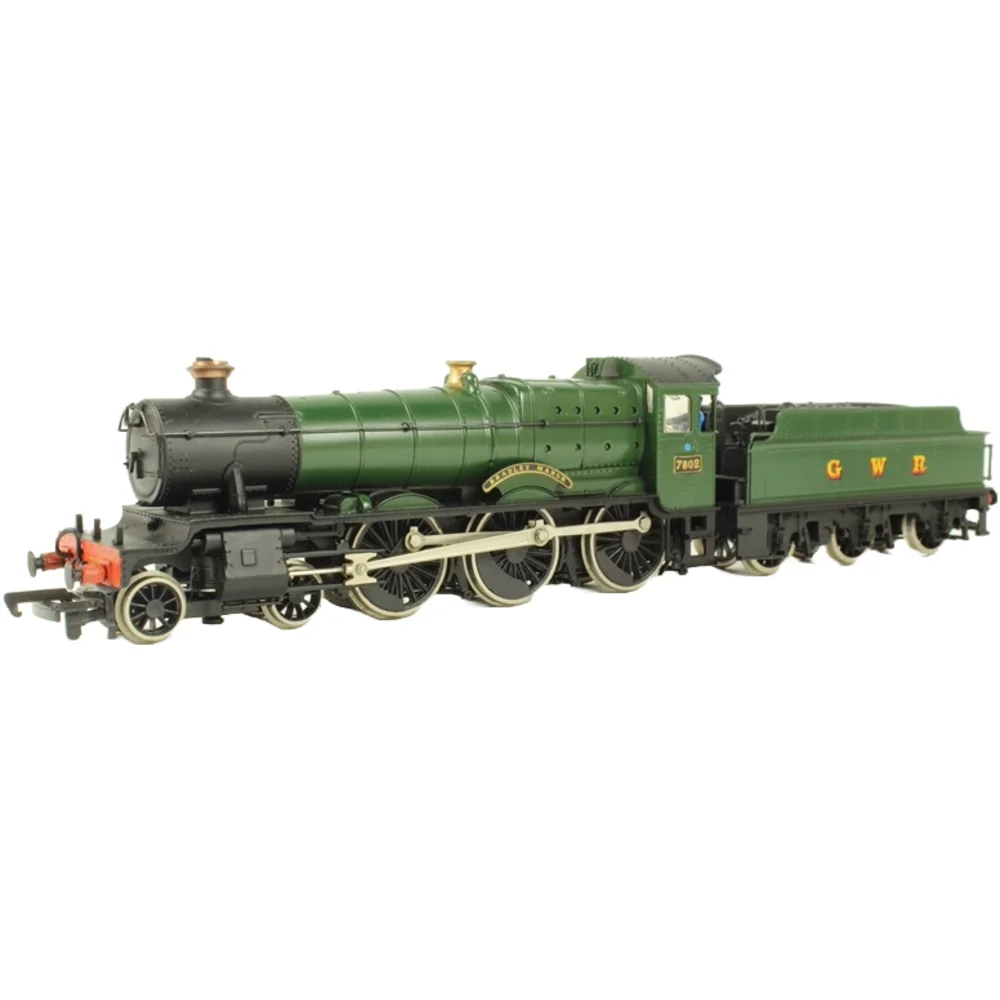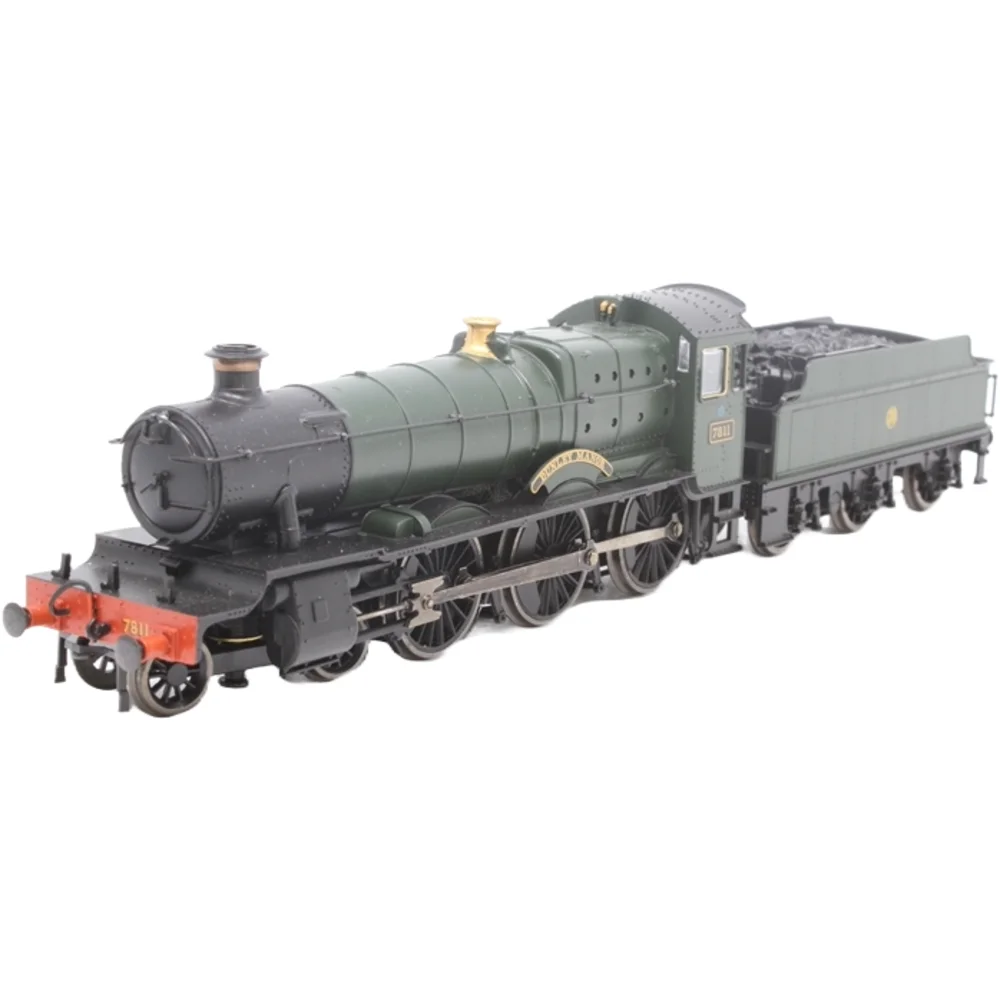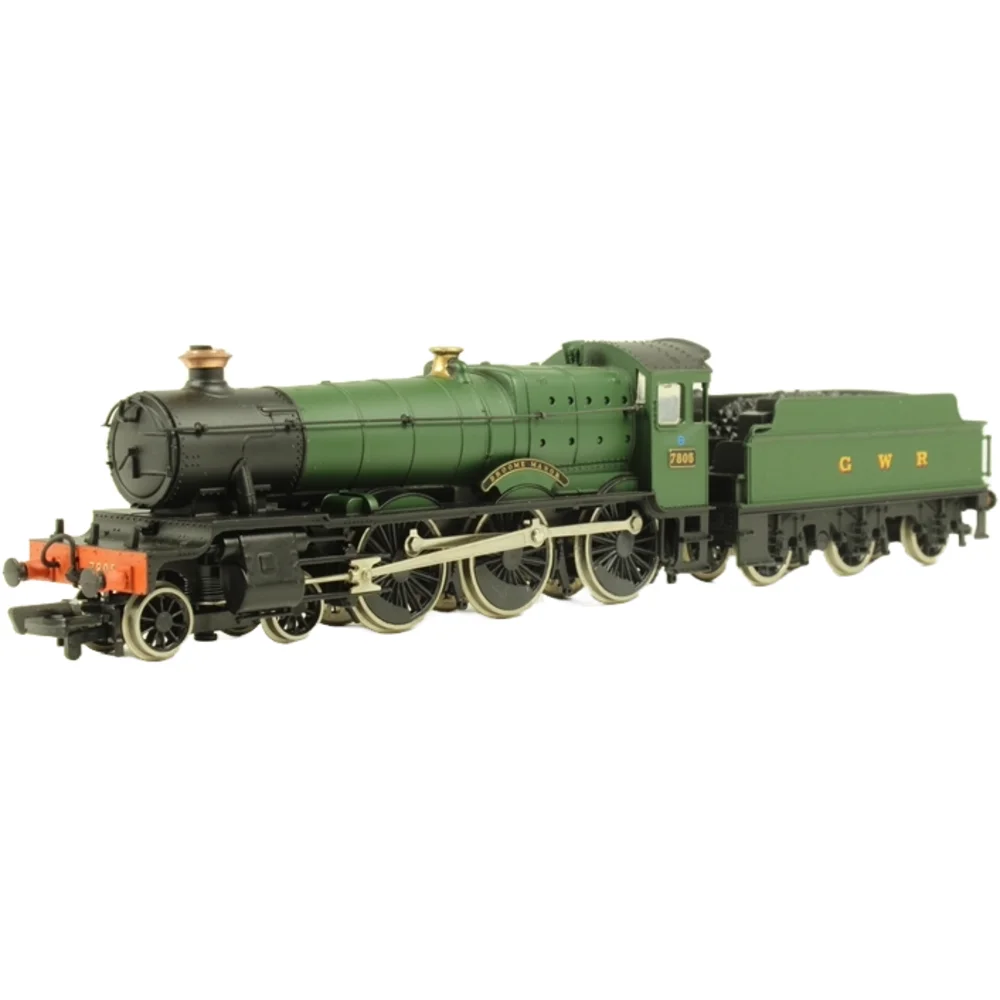GWR 7800 Manor Class: Complete Guide to History, Models & Modelling
Contents
The GWR 7800 Manor Class represents one of the most elegant solutions to a uniquely British railway problem: how to provide modern, powerful motive power for routes with strict weight restrictions. Designed by Charles Collett in the late 1930s as a lighter alternative to the successful Grange Class, these distinctive 4-6-0 locomotives became the final express passenger design to emerge from Swindon Works during the Collett era.
With their characteristic Standard No. 14 boilers and graceful proportions, the thirty Manor Class locomotives carved out a special niche on the Great Western Railway network. From the challenging gradients of the Cambrian Coast line to the branch lines of Cornwall, these versatile machines proved that weight restrictions need not compromise performance or elegance.
For model railway enthusiasts, the GWR 7800 Manor Class offers compelling prototype appeal: historically significant, visually striking, and blessed with fascinating operational stories. Nine locomotives survive in preservation, making them a familiar sight on heritage railways and a popular choice for detailed scale reproduction.
Quick Takeaways
- Thirty locomotives built: Twenty constructed 1938-1939, additional ten built by British Railways in 1950 at Swindon Works
- Lightweight design innovation: Standard No. 14 boiler made them 5 tons lighter than Granges, enabling 'Blue' route classification
- Cambrian Coast specialists: Became synonymous with the prestigious Cambrian Coast Express service from Shrewsbury to Aberystwyth
- Performance improvement: 1952 modifications doubled steaming capacity from 10,000 to 20,400 pounds per hour
- Exceptional preservation rate: Nine locomotives survive (30% of class) with four achieving main line certification in preservation
- Current model availability: Recently released by both Dapol and Accurascale in OO gauge with high accuracy and detail levels
- Barry Scrapyard survivors: Eight of nine preserved examples were rescued from Woodham Brothers scrapyard between 1970-1981
Historical Background and Context
The genesis of the Manor Class lay in a fundamental limitation affecting the GWR's otherwise successful 4-6-0 designs. By the late 1930s, both the Hall and Grange classes had proven themselves as capable mixed-traffic locomotives, but their weight classifications severely restricted their route availability. The 'Red' classification assigned to these heavier locomotives prohibited their use on numerous secondary routes and branch lines where weight restrictions were paramount.
Charles Collett, who had succeeded George Jackson Churchward as Chief Mechanical Engineer in 1922, recognized that the GWR needed a modern 4-6-0 design capable of operating over 'Blue' classified routes. This requirement was particularly pressing on the former Cambrian Railways network in Wales, where the infrastructure had been built to lighter standards but where passenger services demanded more powerful locomotives than the aging 4300 Class 2-6-0s could provide.
The solution lay in developing a locomotive that retained the power and reliability of the Grange Class while achieving a significant weight reduction. This led to the creation of the Standard No. 14 boiler, a masterpiece of engineering compromise that provided adequate steam generation while shedding precious tons from the locomotive's overall weight.
Insider Tip: Component Recycling
The first twenty Manor Class locomotives ingeniously reused components from withdrawn 4300 Class 2-6-0s, including wheels and motion parts. This practical approach reduced costs while ensuring proven reliability. Modellers can identify these recycled components by the slightly different wheel center patterns visible on preserved examples like 7812 Erlestoke Manor.
The decision to name the class after manors within the Great Western Railway's territory reflected both marketing sophistication and operational reality. Unlike the grand castles and halls that gave their names to heavier express locomotives, manors suggested accessible, comfortable destinations that perfectly matched the class's role serving smaller towns and rural communities.
Construction began in 1937, with the first locomotive, 7800 Torquay Manor, entering service in January 1938. The initial order for twenty locomotives proceeded smoothly, with all examples completed by February 1939. However, the outbreak of World War II halted plans for additional construction, leaving the class smaller than originally intended and setting the stage for an unexpected postwar revival.
Design and Technical Specifications
The heart of the Manor Class design was the innovative Standard No. 14 boiler, representing Collett's most successful attempt to balance power output with weight restrictions. This smaller-diameter boiler featured a parallel barrel design with a Belpaire firebox, departing from Churchward's characteristic tapered boiler profile while maintaining the structural advantages of the Belpaire design.
The weight-saving measures extended throughout the locomotive design. The frames were built to lighter scantlings than the Grange Class, while the motion components benefited from advances in metallurgy that allowed strength to be maintained with less material. The result was a locomotive weighing 68 tons 18 cwt compared to the Grange's 73 tons 14 cwt, a reduction sufficient to achieve the crucial 'Blue' route classification.
The locomotives featured the characteristic GWR outside cylinder arrangement with Stephenson valve gear, providing the excellent accessibility that was a hallmark of Swindon design practice. The motion was carefully proportioned to complement the Standard No. 14 boiler's characteristics, ensuring efficient steam usage across the locomotive's operating range.
Perhaps the most visually distinctive feature was the Standard No. 14 boiler itself. While smaller than the boilers fitted to the Grange and Hall classes, its proportions were carefully calculated to provide adequate steaming capacity for the class's intended duties. The parallel barrel design, necessitated by weight constraints, created a subtly different profile that experienced observers could distinguish at considerable distances.
Technical Innovation: Boiler Design Comparison
The Standard No. 14 boiler represented a significant departure from Churchward's tapered boiler philosophy. While the parallel barrel design was less thermodynamically efficient, it achieved crucial weight savings while maintaining adequate steam generation for secondary route duties. This compromise perfectly illustrated Collett's pragmatic approach to locomotive engineering.
The tender design followed established GWR practice with some detail refinements. The 3,500-gallon water capacity provided adequate range for most secondary route duties, while the distinctive curved tender sides maintained the elegant profile that characterized GWR express passenger locomotives. Various tender modifications appeared throughout the class's service life, including different spring hanger arrangements and underframe details that provide fascinating prototype variations for serious modellers.
Service History and Operations
The Manor Class quickly established itself in roles perfectly suited to its capabilities and weight restrictions. The locomotives were initially allocated to depots handling secondary passenger services and mixed-traffic duties, particularly in Wales and the West Country where their 'Blue' classification opened up routes forbidden to heavier locomotives.
The Cambrian Railways network became the class's spiritual home, with Manor locomotives working the prestigious Cambrian Coast Express from Shrewsbury to Aberystwyth. This demanding service showcased the class's abilities, requiring sustained high-speed running over challenging gradients while maintaining the punctuality essential for this premier train. The sight of a Manor climbing toward Talerddig summit with the Coast Express became one of the most iconic images of post-war British steam operation.
In the West Country, Manor Class locomotives proved invaluable for banking and piloting duties over the challenging Devon banks between Newton Abbot and Plymouth. Their light axle loading allowed them to cross the Royal Albert Bridge and work Cornwall's branch lines, extending modern motive power to routes that had previously relied on aging Victorian designs.
However, the class's early service record was marred by disappointing performance that threatened its reputation. Initial steaming rates of just 10,000 pounds per hour were inadequate for the demanding duties assigned to the locomotives, leading to complaints from running departments and calls for design modifications.
The 1952 Performance Revolution
Following extensive testing of 7818 Granville Manor at Swindon, engineers discovered that modifications to the blastpipe arrangement and firebox design could dramatically improve performance. The resulting modifications doubled steaming capacity to 20,400 pounds per hour, transforming the class from disappointing underperformers to reliable workhorses. This improvement program was implemented across the fleet from July 1954 onwards.
The transformation following the 1952 modifications was remarkable. Manor Class locomotives that had previously struggled with moderate loads suddenly became capable of handling substantial trains with confidence. This improvement came just in time to secure their role in British Railways' rationalization program, ensuring continued production and extended service lives.
During their later years, the Manor Class developed a devoted following among railway enthusiasts. The locomotives were often turned out in immaculate condition by dedicated depot staff, particularly on the Cambrian section where clean locomotives had become increasingly rare in the declining years of steam. This attention to presentation reflected both professional pride and recognition of the class's special place in Welsh railway operation.
Fleet
| Ordered By | Built By | Built | Withdrawn | Length Of Service | Running Numbers | Names |
|---|---|---|---|---|---|---|
| Great Western Railway | Great Western Railway | January 1938 | August 1964 | 26.6 years | GWR 7800, BR 7800 | Torquay Manor |
| Great Western Railway | Great Western Railway | January 1938 | July 1965 | 27.5 years | GWR 7801, BR 7801 | Anthony Manor |
| Great Western Railway | Great Western Railway | January 1938 | November 1965 | 27.8 years | GWR 7802, BR 7802 | Bradley Manor |
| Great Western Railway | Great Western Railway | January 1938 | April 1965 | 27.3 years | GWR 7803, BR 7803 | Barcote Manor |
| Great Western Railway | Great Western Railway | February 1938 | September 1965 | 27.6 years | GWR 7804, BR 7804 | Baydon Manor |
| Great Western Railway | Great Western Railway | March 1938 | December 1964 | 26.8 years | GWR 7805, BR 7805 | Broome Manor |
| Great Western Railway | Great Western Railway | March 1938 | November 1964 | 26.7 years | GWR 7806, BR 7806 | Cockington Manor |
| Great Western Railway | Great Western Railway | March 1938 | November 1964 | 26.7 years | GWR 7807, BR 7807 | Compton Manor |
| Great Western Railway | Great Western Railway | March 1938 | December 1965 | 27.8 years | GWR 7808, BR 7808 | Cookham Manor |
| Great Western Railway | Great Western Railway | April 1938 | April 1963 | 25.0 years | GWR 7809, BR 7809 | Childrey Manor |
| Great Western Railway | Great Western Railway | December 1938 | September 1964 | 25.8 years | GWR 7810, BR 7810 | Draycott Manor |
| Great Western Railway | Great Western Railway | December 1938 | July 1965 | 26.6 years | GWR 7811, BR 7811 | Dunley Manor |
| Great Western Railway | Great Western Railway | January 1939 | November 1965 | 26.8 years | GWR 7812, BR 7812 | Erlestoke Manor |
| Great Western Railway | Great Western Railway | January 1939 | May 1965 | 26.3 years | GWR 7813, BR 7813 | Freshford Manor |
| Great Western Railway | Great Western Railway | January 1939 | September 1965 | 26.7 years | GWR 7814, BR 7814 | Fringford Manor |
| Great Western Railway | Great Western Railway | January 1939 | October 1964 | 25.8 years | GWR 7815, BR 7815 | Fritwell Manor |
| Great Western Railway | Great Western Railway | January 1939 | November 1965 | 26.8 years | GWR 7816, BR 7816 | Frilsham Manor |
| Great Western Railway | Great Western Railway | January 1939 | June 1964 | 25.4 years | GWR 7817, BR 7817 | Garsington Manor |
| Great Western Railway | Great Western Railway | January 1939 | January 1965 | 26.0 years | GWR 7818, BR 7818 | Granville Manor |
| Great Western Railway | Great Western Railway | February 1939 | November 1965 | 26.8 years | GWR 7819, BR 7819 | Hinton Manor |
| British Railways | British Railways | November 1950 | November 1965 | 15.0 years | BR 7820 | Dinmore Manor |
| British Railways | British Railways | November 1950 | November 1965 | 15.0 years | BR 7821 | Ditcheat Manor |
| British Railways | British Railways | December 1950 | November 1965 | 14.9 years | BR 7822 | Foxcote Manor |
| British Railways | British Railways | December 1950 | July 1964 | 13.6 years | BR 7823 | Hook Norton Manor |
| British Railways | British Railways | December 1950 | November 1964 | 13.9 years | BR 7824 | Ilford Manor |
| British Railways | British Railways | December 1950 | May 1964 | 13.4 years | BR 7825 | Lechlade Manor |
| British Railways | British Railways | December 1950 | April 1965 | 14.3 years | BR 7826 | Longworth Manor |
| British Railways | British Railways | December 1950 | October 1965 | 14.8 years | BR 7827 | Lydham Manor |
| British Railways | British Railways | December 1950 | October 1965 | 14.8 years | BR 7828 | Odney Manor |
| British Railways | British Railways | December 1950 | December 1965 | 15.0 years | BR 7829 | Ramsbury Manor |
Withdrawal and Preservation Legacy
Despite their relatively recent construction and improved performance, the Manor Class faced early withdrawal as British Railways pursued dieselization policies. The first casualty was 7809 Childrey Manor in April 1963, marking the beginning of a rapid decline that would see the entire class withdrawn within three years.
The concentration of withdrawals in 1965 reflected both the progress of dieselization and the specialized nature of the class's duties. As diesel multiple units took over secondary passenger services and new diesel locomotives handled remaining locomotive-hauled trains, there was little scope for retaining steam locomotives optimized for routes that were rapidly losing their passenger services.
The final two Manor Class locomotives in service, 7808 Cookham Manor and 7829 Ramsbury Manor, survived until the very end of Western Region steam operations on December 31st, 1965. Their withdrawal marked not just the end of the class but the conclusion of nearly three decades of passenger steam operation on many former GWR routes.
Remarkably, nine locomotives survived the mass scrapping program, representing an exceptional 30% preservation rate for a relatively small class. This high survival rate reflected several factors: the class's distinctive appearance, its association with popular tourist routes, and the timing of withdrawals that coincided with emerging preservation efforts.
7808 Cookham Manor holds the distinction of being the only Manor purchased directly from British Railways for preservation. The Great Western Society's acquisition in 1966 ensured that at least one example would survive with authentic fittings and equipment intact. The remaining eight survivors were all rescued from Woodham Brothers' scrapyard at Barry, with 7827 Lydham Manor departing as early as June 1970 and 7828 Odney Manor leaving as late as June 1981.
Preservation Success Stories
All four GWR-built Manor locomotives (7802, 7808, 7812, and 7819) achieved main line certification during their preservation careers, with 7802 Bradley Manor starring in Disney's "The Chronicles of Narnia" film in 2005. The preserved fleet has operated across Britain's heritage railway network, ensuring that new generations can experience the class's distinctive character and operational capabilities.
The preserved Manor Class locomotives have become ambassadors for GWR engineering excellence, operating on heritage railways from the Severn Valley Railway to the West Somerset Railway. Their continued operation provides invaluable opportunities for research and documentation, ensuring that knowledge of Collett's design principles continues to inform historical understanding and model railway reproduction.
Modelling Significance and Scale Replications
The GWR 7800 Manor Class has attracted significant attention from model railway manufacturers, reflecting both its historical importance and its appealing proportions. The class's elegant lines, moderate size, and distinctive features make it an ideal subject for detailed scale reproduction across multiple gauges.
In OO gauge, the class has been represented by several manufacturers over the decades, with each generation bringing improvements in accuracy and detail. Early representations from manufacturers like Mainline Railways in the 1980s captured the basic proportions while lacking the fine detail expected by contemporary modellers. These pioneering efforts nonetheless served to introduce the class to model railway enthusiasts and established its popularity.
The most significant recent developments have been the release of highly detailed Manor Class models from both Dapol and Accurascale in autumn 2022. These competing models represent the current state of the art in OO gauge locomotive reproduction, featuring unprecedented accuracy and attention to prototype variations.
Dapol's Manor Class (catalog DAP-4S-020-XXX series) benefits from engineering lessons learned during their successful Mogul project. The model features a 30:1 gear ratio for excellent slow-speed performance, enhanced crosshead detailing, and working vacuum pump representation. The slide-out PCB design simplifies DCC installation, while the wire-free drawbar connection ensures reliable electrical continuity between locomotive and tender.
Accurascale's Manor Class (catalog ACC-25XX-XXX series) is based on 3D scanning of preserved 7808 Cookham Manor combined with original works drawings provided by the Great Western Society. This collaboration with preservation groups has enabled exceptional accuracy in reproducing subtle prototype variations, including different tender types, chimney profiles, and fitting arrangements.
Models
| Builder | Catalogue # | Year | Running # | Class, Operator (Livery) "Name" | Scale | Finish | Era | DCC |
|---|---|---|---|---|---|---|---|---|
| Accurascale | ACC2500-7800 | 7800 | Great Western Railway 7800, British Railways (Lined Green with Late Crest) "Torquay Manor" | OO | P | 5 | DCC21 | |
| Accurascale | ACC2500-7800DCC | 7800 | Great Western Railway 7800, British Railways (Lined Green with Late Crest) "Torquay Manor" | OO | P | 5 | DCCF | |
| Accurascale | ACC2501-7801 | 7801 | Great Western Railway 7800, Great Western Railway (Green) "Anthony Manor" | OO | P | 3 | DCC21 | |
| Accurascale | ACC2501-7801DCC | 7801 | Great Western Railway 7800, Great Western Railway (Green) "Anthony Manor" | OO | P | 3 | DCCF | |
| Accurascale | ACC2503-7808 | 7808 | Great Western Railway 7800, Great Western Railway (Green) "Cookham Manor" | OO | P | 3 | DCC21 | |
| Accurascale | ACC2503-7808DCC | 7808 | Great Western Railway 7800, Great Western Railway (Green) "Cookham Manor" | OO | P | 3 | DCCF | |
| Accurascale | ACC2504-7810 | 7810 | Great Western Railway 7800, British Railways (Lined Green with Early Emblem) "Draycott Manor" | OO | P | 4 | DCC21 | |
| Accurascale | ACC2504-7810DCC | 7810 | Great Western Railway 7800, British Railways (Lined Green with Early Emblem) "Draycott Manor" | OO | P | 4 | DCCF | |
| Accurascale | ACC2505-7812 | 7812 | Great Western Railway 7800, British Railways (Lined Green with Late Crest) "Erlestoke Manor" | OO | P | 5 | DCC21 | |
| Accurascale | ACC2505-7812DCC | 7812 | Great Western Railway 7800, British Railways (Lined Green with Late Crest) "Erlestoke Manor" | OO | P | 5 | DCCF | |
| Accurascale | ACC2506-7814 | 7814 | Great Western Railway 7800, British Railways (Black with Early Emblem) "Fringford Manor" | OO | P | 4 | DCC21 | |
| Accurascale | ACC2506-7814DCC | 7814 | Great Western Railway 7800, British Railways (Black with Early Emblem) "Fringford Manor" | OO | P | 4 | DCCF | |
| Accurascale | ACC2507-7818 | 7818 | Great Western Railway 7800, Great Western Railway (Green) "Granville Manor" | OO | P | 3 | DCC21 | |
| Accurascale | ACC2507-7818DCC | 7818 | Great Western Railway 7800, Great Western Railway (Green) "Granville Manor" | OO | P | 3 | DCCF | |
| Accurascale | ACC2508-7819 | 7819 | Great Western Railway 7800, Great Western Railway (Green) "Hinton Manor" | OO | P | 3 | DCC21 | |
| Accurascale | ACC2508-7819DCC | 7819 | Great Western Railway 7800, Great Western Railway (Green) "Hinton Manor" | OO | P | 3 | DCCF | |
| Accurascale | ACC2509-7820 | 7820 | Great Western Railway 7800, British Railways (Lined Black with Early Emblem) "Dinmore Manor" | OO | P | 4 | DCC21 | |
| Accurascale | ACC2509-7820DCC | 7820 | Great Western Railway 7800, British Railways (Lined Black with Early Emblem) "Dinmore Manor" | OO | P | 4 | DCCF | |
| Accurascale | ACC2510-7824 | 7824 | Great Western Railway 7800, British Railways (Black with Early Emblem) "Ilford Manor" | OO | P | 4 | DCC21 | |
| Accurascale | ACC2510-7824DCC | 7824 | Great Western Railway 7800, British Railways (Black with Early Emblem) "Ilford Manor" | OO | P | 4 | DCCF | |
| Bachmann | 30-021 | 2006 | 7811 | Great Western Railway 7800, Great Western Railway (Green with Monogram) "Dunley Manor" | OO | P | 3 | No |
| Bachmann | 30-061* | 7819 | Great Western Railway 7800, British Railways (Black with Early Emblem) "Hinton Manor" | OO | P | 4 | No | |
| Bachmann | 30-400 | 1992 | 7829 | Great Western Railway 7800, British Railways (Lined Black with Late Crest) "Ramsbury Manor" | OO | P | 5 | No |
| Bachmann | 31-2000* | 2000 | 7828 | Great Western Railway 7800, British Railways (Lined Black with Late Crest) "Odney Manor" | OO | P | 5 | No |
| Bachmann | 31-300 | 1990 | 7802 | Great Western Railway 7800, Great Western Railway (Green) "Bradley Manor" | OO | P | 3 | No |
| Bachmann | 31-300Z* | 7816 | Great Western Railway 7800, British Railways (Green with Early Emblem) "Frilsham Manor" | OO | P | 4 | No | |
| Bachmann | 31-301 | 1990 | 7820 | Great Western Railway 7800, British Railways (Green with Early Emblem) "Dinmore Manor" | OO | P | 4 | No |
| Bachmann | 31-302 | 1990 | 7823 | Great Western Railway 7800, British Railways (Lined Green with Late Crest) "Hook Norton Manor" | OO | P | 5 | No |
| Bachmann | 31-303 | 1990 | 7829 | Great Western Railway 7800, British Railways (Lined Black with Early Emblem) "Ramsbury Manor" | OO | P | 4 | No |
| Bachmann | 31-303A | 1999 | 7829 | Great Western Railway 7800, British Railways (Lined Black with Early Emblem) "Ramsbury Manor" | OO | P | 4 | No |
| Bachmann | 31-304 | 1995 | 7800 | Great Western Railway 7800, Great Western Railway (Green) "Torquay Manor" | OO | P | 3 | No |
| Bachmann | 31-305 | 1995 | 7805 | Great Western Railway 7800, Great Western Railway (Green) "Broome Manor" | OO | P | 3 | No |
| Bachmann | 31-306 | 1995 | 7822 | Great Western Railway 7800, British Railways (Lined Green with Late Crest) "Foxcote Manor" | OO | P | 5 | No |
| Bachmann | 31-307 | 2002 | 7813 | Great Western Railway 7800, British Railways (Black with Early Emblem) "Freshford Manor" | OO | P | 4 | No |
| Bachmann | 31-308 | 2006 | 7825 | Great Western Railway 7800, British Railways (Lined Green with Late Crest) "Lechlade Manor" | OO | P | 5 | No |
| Dapol | 2S-001-000 | 7810 | Great Western Railway 7800, British Railways (Lined Green with Late Crest) "Draycott Manor" | N | P | 5 | DCC6 | |
| Dapol | 2S-001-000D | 7810 | Great Western Railway 7800, British Railways (Lined Green with Late Crest) "Draycott Manor" | N | P | 5 | DCCF | |
| Dapol | 2S-001-001 | 7801 | Great Western Railway 7800, Great Western Railway (Green) "Anthony Manor" | N | P | 3 | DCC6 | |
| Dapol | 2S-001-001D | 7801 | Great Western Railway 7800, Great Western Railway (Green) "Anthony Manor" | N | P | 3 | DCCF | |
| Dapol | 2S-001-003 | 7805 | Great Western Railway 7800, Great Western Railway (Green) "Broome Manor" | N | P | 3 | DCC6 | |
| Dapol | 2S-001-003D | 7805 | Great Western Railway 7800, Great Western Railway (Green) "Broome Manor" | N | P | 3 | DCCF | |
| Dapol | 2S-001-004 | 7821 | Great Western Railway 7800, British Railways (Black with Early Emblem) "Ditcheat Manor" | N | P | 4 | DCC6 | |
| Dapol | 2S-001-004D | 7821 | Great Western Railway 7800, British Railways (Black with Early Emblem) "Ditcheat Manor" | N | P | 4 | DCCF | |
| Dapol | 4S-001-001 | 7800 | Great Western Railway 7800, Great Western Railway (Green with Monogram) "Torquay Manor" | OO | P | 3 | N18DCC | |
| Dapol | 4S-001-001D | 7800 | Great Western Railway 7800, Great Western Railway (Green with Monogram) "Torquay Manor" | OO | P | 3 | DCCF | |
| Dapol | 4S-001-001S | 7800 | Great Western Railway 7800, Great Western Railway (Green with Monogram) "Torquay Manor" | OO | P | 3 | DCCS | |
| Dapol | 4S-001-002 | 7814 | Great Western Railway 7800, Great Western Railway (Green) "Fringford Manor" | OO | P | 3 | N18DCC | |
| Dapol | 4S-001-002D | 7814 | Great Western Railway 7800, Great Western Railway (Green) "Fringford Manor" | OO | P | 3 | DCCF | |
| Dapol | 4S-001-002S | 7814 | Great Western Railway 7800, Great Western Railway (Green) "Fringford Manor" | OO | P | 3 | DCCS | |
| Dapol | 4S-001-003 | 7807 | Great Western Railway 7800, Great Western Railway (Green) "Compton Manor" | OO | P | 3 | N18DCC | |
| Dapol | 4S-001-003D | 7807 | Great Western Railway 7800, Great Western Railway (Green) "Compton Manor" | OO | P | 3 | DCCF | |
| Dapol | 4S-001-003S | 7807 | Great Western Railway 7800, Great Western Railway (Green) "Compton Manor" | OO | P | 3 | DCCS | |
| Dapol | 4S-001-004 | 7823 | Great Western Railway 7800, British Railways (Lined Black with Early Emblem) "Hook Norton Manor" | OO | P | 4 | N18DCC | |
| Dapol | 4S-001-004D | 7823 | Great Western Railway 7800, British Railways (Lined Black with Early Emblem) "Hook Norton Manor" | OO | P | 4 | DCCF | |
| Dapol | 4S-001-004S | 7823 | Great Western Railway 7800, British Railways (Lined Black with Early Emblem) "Hook Norton Manor" | OO | P | 4 | DCCS | |
| Dapol | 4S-001-005 | 7819 | Great Western Railway 7800, British Railways (Black with Early Emblem) "Hinton Manor" | OO | P | 4 | N18DCC | |
| Dapol | 4S-001-005D | 7819 | Great Western Railway 7800, British Railways (Black with Early Emblem) "Hinton Manor" | OO | P | 4 | DCCF | |
| Dapol | 4S-001-005S | 7819 | Great Western Railway 7800, British Railways (Black with Early Emblem) "Hinton Manor" | OO | P | 4 | DCCS | |
| Dapol | 4S-001-006 | 7810 | Great Western Railway 7800, British Railways (Lined Green with Early Emblem) "Draycott Manor" | OO | P | 4 | N18DCC | |
| Dapol | 4S-001-006D | 7810 | Great Western Railway 7800, British Railways (Lined Green with Early Emblem) "Draycott Manor" | OO | P | 4 | DCCF | |
| Dapol | 4S-001-006S | 7810 | Great Western Railway 7800, British Railways (Lined Green with Early Emblem) "Draycott Manor" | OO | P | 4 | DCCS | |
| Dapol | 4S-001-007 | 7827 | Great Western Railway 7800, British Railways (Lined Green with Late Crest) "Lydham Manor" | OO | P | 5 | N18DCC | |
| Dapol | 4S-001-007D | 7827 | Great Western Railway 7800, British Railways (Lined Green with Late Crest) "Lydham Manor" | OO | P | 5 | DCCF | |
| Dapol | 4S-001-007S | 7827 | Great Western Railway 7800, British Railways (Lined Green with Late Crest) "Lydham Manor" | OO | P | 5 | DCCS | |
| Dapol | 4S-001-008 | 7820 | Great Western Railway 7800, British Railways (Lined Black with Early Emblem) "Dinmore Manor" | OO | P | 4 | N18DCC | |
| Dapol | 4S-001-008D | 7820 | Great Western Railway 7800, British Railways (Lined Black with Early Emblem) "Dinmore Manor" | OO | P | 4 | DCCF | |
| Dapol | 4S-001-008S | 7820 | Great Western Railway 7800, British Railways (Lined Black with Early Emblem) "Dinmore Manor" | OO | P | 4 | DCCS | |
| Mainline | 37043 | 7827 | Great Western Railway 7800, British Railways (Lined Green with Late Crest) "Lydham Manor" | OO | P | 5 | No | |
| Mainline | 37071 | 7812 | Great Western Railway 7800, British Railways (Lined Black with Early Emblem) "Erlestoke Manor" | OO | P | 4 | No | |
| Mainline | 37078 | 7819 | Great Western Railway 7800, Great Western Railway (Green) "Hinton Manor" | OO | P | 3 | No | |
| Mainline | 37078 | 7808 | Great Western Railway 7800, Great Western Railway (Green) "Cookham Manor" | OO | P | 3 | No | |
| Mainline | 37079 | 7812 | Great Western Railway 7800, British Railways (Lined Black with Early Emblem) "Erlestoke Manor" | OO | P | 4 | No | |
| Mainline | 937100 | 7808 | Great Western Railway 7800, Great Western Railway (Green) "Cookham Manor" | OO | P | 3 | No |
Both contemporary manufacturers have paid particular attention to representing the variations found within the class. Different chimney profiles reflecting pre-and post-1952 modifications, various tender configurations including riveted and flush-sided types, and subtle differences in fittings all contribute to the prototype accuracy that serious modellers demand.
For kit builders and scratch builders, the Manor Class offers excellent opportunities for creating unique models that capture specific prototype variations. Several specialist manufacturers have produced white metal and etched brass kits that allow construction of highly detailed models incorporating all the subtle differences found between individual locomotives.
Unique Modelling Tips and Layout Integration
Successfully integrating Manor Class models into layout operation requires understanding the specialized nature of their prototype duties. Unlike main line express locomotives that might work prestigious named trains between major cities, the Manors were typically assigned to secondary services that connected smaller communities with the main network.
Authentic operating scenarios should reflect this mixed-traffic role. A typical Manor duty might involve hauling a local passenger service in the morning, working a freight turn during the afternoon, and returning to passenger service for the evening commuter traffic. This variety of duties provides excellent operational interest while remaining true to prototype practice.
The Cambrian Coast Express represents the most prestigious service associated with the class and provides compelling layout scenarios. The sight of a Manor departing Shrewsbury with a rake of corridor coaches bound for Aberystwyth captures the essence of post-war British railway operation, combining modern motive power with traditional passenger amenities.
Weathering Authenticity for Mixed-Traffic Operation
Manor Class weathering should reflect their mixed-traffic duties while maintaining the relatively clean appearance expected of locomotives handling passenger services. Focus on subtle coal dust around the bunker area, light oil staining around motion components, and graduated exhaust effects on the smokebox. Avoid heavy industrial weathering that would be inappropriate for passenger-rated locomotives.
Layout design should accommodate the class's route restrictions and typical operating environment. Secondary stations with modest platforms, passing loops for freight operations, and junction arrangements reflecting the mixed nature of Manor duties all contribute to authentic operational scenarios. The infrastructure should suggest rural or semi-rural locations rather than major urban centers.
Coaching stock selection requires careful attention to period authenticity. Manor Class locomotives typically hauled trains consisting of four to eight coaches, depending on the service and season. GWR corridor stock from the 1930s onwards provides appropriate formations, while the distinctive chocolate and cream livery creates visually striking consists that complement the locomotives' elegant appearance.
For freight operation, Manor locomotives were capable of handling substantial loads on favorable gradients while requiring assistance or reduced loads on challenging routes. Mixed freight consists including livestock wagons, general merchandise, and seasonal traffic like fruit and vegetables from West Country sources provide authentic operational variety.
Sound-equipped models benefit from careful attention to the Manor Class's distinctive exhaust characteristics. The Standard No. 14 boiler created a particular exhaust note that differed subtly from larger GWR locomotives, while the relatively light axle loading produced characteristic wheel-rail interaction sounds that added to the class's auditory signature.
Finally
The GWR 7800 Manor Class represents far more than a simple weight-saving exercise; these thirty locomotives embodied the intelligent compromise between engineering constraints and operational requirements that characterized the best of British locomotive design. From their problematic early years to their transformation into reliable workhorses, the Manor Class story illustrates both the challenges of innovation and the rewards of persistent engineering refinement.
For railway historians, the class provides fascinating insights into the practical realities of railway operation during a period of technological transition. The weight restrictions that necessitated their design, the performance problems that nearly doomed the class, and the modifications that secured their success all demonstrate how real-world constraints shaped locomotive development in ways that pure engineering theory could not predict.
The exceptional preservation rate of thirty percent ensures that future generations can continue to appreciate these elegant machines in operation. From the static display of 7808 Cookham Manor at Didcot to the active restoration projects maintaining other class members in running condition, the preserved fleet serves as living testament to Collett's achievement in creating locomotives that combined engineering sophistication with enduring visual appeal.
Model railway enthusiasts find in the Manor Class an ideal subject that balances historical significance with practical modeling opportunities. The class's moderate size suits layouts of all scales, while the variety of liveries, modifications, and operational scenarios provides endless possibilities for authentic recreation. Whether representing the challenges of Welsh mountain operation or the genteel branch line services of rural England, Manor Class models bring character and authenticity to any Great Western themed layout.
As the railway preservation movement continues to evolve and new generations discover the fascination of steam locomotion, the GWR 7800 Manor Class stands as a perfect introduction to the complexity and elegance of British locomotive engineering. These machines prove that constraints need not compromise excellence, and that the most successful designs often emerge from the most challenging requirements.
Frequently Asked Questions
How many GWR 7800 Manor Class locomotives were built?
Thirty locomotives comprised the complete Manor Class roster: twenty built between 1938-1939 during the GWR era, and an additional ten constructed by British Railways in 1950. A planned second batch of ten BR locomotives was cancelled for unknown reasons, which would have brought the total to forty locomotives.
What made the Manor Class different from the Grange Class?
The Manor Class featured a smaller Standard No. 14 boiler that reduced locomotive weight by over 5 tons compared to the Grange Class. This weight saving achieved 'Blue' route classification, allowing operation over weight-restricted secondary routes forbidden to heavier locomotives. The maximum axle load was reduced to 17 tons 5 cwt compared to the Grange's heavier loading.
Why did the Manor Class initially perform poorly?
Early Manor Class locomotives suffered from inadequate steaming capacity of only 10,000 pounds per hour due to poor blastpipe and firebox design. The blastpipe was too large in relation to the chimney size, restricting both steam flow and draught on the fire. Modifications implemented from 1952 onwards doubled this capacity to 20,400 pounds per hour, transforming the class's operational capabilities.
What was the Cambrian Coast Express and why were Manor locomotives used?
The Cambrian Coast Express was the premier passenger service from London Paddington to Aberystwyth and Pwllheli via Shrewsbury. Manor Class locomotives typically worked the Welsh section from Shrewsbury onwards, as their 'Blue' route classification allowed them to operate over the weight-restricted infrastructure of the former Cambrian Railways network, where heavier locomotives were prohibited.
Did any Manor Class locomotives work outside Wales?
Yes, Manor Class locomotives worked throughout the former GWR network including the West Country, where they provided banking assistance over Devon banks between Newton Abbot and Plymouth and worked Cornwall branch lines. Some also operated from Reading depot on Southern Region metals to Guildford and Redhill, demonstrating their versatility across different route types.
Which Manor Class locomotives are preserved today?
Nine locomotives survive in preservation: 7802 Bradley Manor, 7808 Cookham Manor, 7812 Erlestoke Manor, 7819 Hinton Manor, 7820 Dinmore Manor, 7821 Ditcheat Manor, 7822 Foxcote Manor, 7827 Lydham Manor, and 7828 Odney Manor. Remarkably, all four GWR-built examples achieved main line certification during their preservation careers, with several starring in heritage railway operations and film productions.
Where can I see a preserved Manor Class locomotive?
7808 Cookham Manor is on static display at the Great Western Society's depot at Didcot Railway Centre, providing excellent access for studying construction details. Other preserved examples operate on various heritage railways including the Severn Valley Railway, which hosts both 7802 Bradley Manor and 7812 Erlestoke Manor. Check heritage railway websites for current operational status and special events.
What OO gauge Manor Class models are currently available?
Both Dapol (catalog 4S-020 series) and Accurascale (catalog 2301 series) released highly detailed OO gauge Manor Class models in autumn 2022. These premium models feature unprecedented accuracy, multiple livery options, DCC compatibility, and sound capability. Earlier Bachmann models using former Mainline tooling are also available on the secondhand market at more affordable prices.
Are Manor Class models available in other scales besides OO gauge?
N gauge models were produced by Ixion Models before 2011, with rights later acquired by Dapol. These fine scale models offer excellent detail for the smaller gauge but have limited availability. Some specialist manufacturers have also produced white metal and etched brass kits in various scales for advanced modellers seeking ultimate accuracy and customization options.
What coaching stock should I use with Manor Class models?
Authentic consists should feature GWR corridor coaching stock from the 1930s onwards in chocolate and cream livery. Typical train lengths ranged from four to eight coaches depending on the service, with Hawksworth designs being particularly appropriate for the class's later operational period. Clerestory coaches would be appropriate for early preserved examples representing 1960s-1970s heritage operations.
Are there any Manor Class locomotives still certified for main line operation?
As of 2025, no Manor Class locomotives hold current main line certification. The introduction of On-Train Monitoring Recorder (OTMR) requirements in 2007 effectively ended main line operations for most preserved steam locomotives, with cost and complexity factors preventing Manor Class main line returns. However, several examples remain operational on heritage railways with potential for future main line certification if funding permits.
How do Manor Class locomotives compare to contemporary designs from other railways?
The Manor Class was unique in British practice for combining modern mixed-traffic capabilities with lightweight construction for maximum route availability. While similar in concept to LMS designs for secondary routes, the Manor Class 4-6-0 arrangement provided superior long-distance capabilities and passenger comfort standards. The class represented the ultimate development of the lightweight express passenger locomotive concept in British railway engineering.


